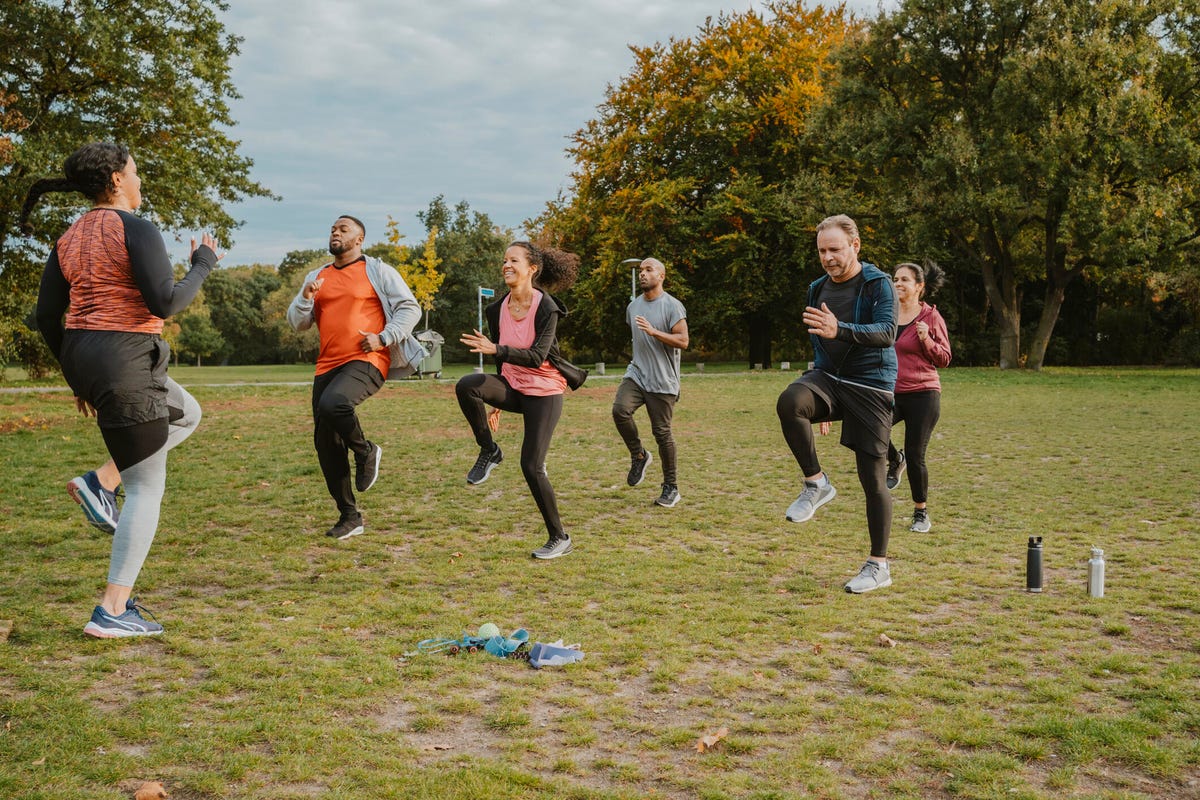Fitness
How Strength Training Can Super Charge Your Weight Loss Journey

Losing fat while gaining muscle is an important part of changing your body composition. This can be tricky, but changing up your diet and exercising consistently is an effective way to achieve this goal. One of the best exercises you can do to lose fat and put on muscle is strength training.
Strength training is effective in helping your body burn fat, not just during your workout but even after the fact. Putting on muscle affects your body composition and your metabolism in significant ways. I spoke to some experts to help explain how strength training helps you lose weight and what you need to know to find success with it.
If you’re looking for more fitness advice, see how many calories you need to burn to lose weight, how to burn body fat at home and the trick you need to lose weight and gain lean muscle at the same time.
Strength training can help you burn more fat.
Cardio versus strength training
There’s a constant back-and-forth argument about which is more efficient in reaching your ideal physique: cardio or strength training. According to New York City-based personal trainer Oscar Colon IV, cardio is ideal for burning more calories during a workout session — and it’s key to keeping your heart strong — but strength training affects your body differently. “Strength training has a two-pronged effect because you burn calories during the workout and during the recovery and restoration of muscle groups you worked,” he says. As a result, you get more results for your effort.
It’s still a good idea to incorporate both cardio and strength training into a well-balanced fitness plan, so you can reap all the benefits. How much you do of one or the other may also depend on your current goals. If you’re training for your first marathon, cardio will be your main focus as you build endurance, whereas strength training will be a priority when you’re trying to get stronger or build muscle.
Read more: Changing Your Body
Putting on muscle helps you burn calories even at rest.

How muscles affect your ability to burn fat
As mentioned, strength training can help you burn more calories during and after your workout. This is thanks to the lean muscle you gain as a result of strength training. If your goal is to lose weight, having more lean muscle can help the process.
This also means that the more lean muscle you have, the higher your resting metabolic rate will be. Your resting metabolic rate, or RMR, refers to the total number of calories your body burns when it’s at rest. Biologically speaking, resting metabolism aids your organ functions, neurological functions, breathing and blood circulation. Rachel MacPherson, an American Council of Exercise-certified personal trainer, performance specialist and Garage Gym Reviews expert, explains that muscle is metabolically active, meaning it burns calories even at rest, and although the effect is small, it’s significant and does add up over time. “This also helps to counteract the decline of metabolism and muscle mass as you age, which can contribute to middle-age weight gain,” she says.
Strength training also has fat-burning benefits when you’re fresh off a workout. “Excess post-exercise oxygen consumption is the process of your body regulating itself back to homeostasis after a strenuous workout,” Colon explains. In other words, you’re still burning calories as you recover, since your body stays warm for a while as it cools down.
Studies have shown that beginners tend to put on muscle faster than those experienced with strength training.

How long it takes to put on muscle
Now that you know that lean muscle is the key component in fat burning, you’re probably wondering how long it takes to build muscle. This will vary from person to person, since genetics, hormones, gender, diet and other factors play a role in how much muscle you put on and how quickly. “If you consistently train three to four times a week for 30 minutes each session, you should realistically start to see results in three to four weeks,” Colon says.
MacPherson says you can put on muscle mass each week, and doing a 12- to 16-week hypertrophy training program is ideal for seeing a significant amount of muscle gain. “You can expect upwards of five to 10 pounds of muscle gain during this time,” she explains, adding, “As you become more advanced you will need to work harder for less gain, but you will still see results.”

That’s another interesting aspect of strength training: If you’re a beginner, you tend to have an advantage over someone more experienced when building muscle. This is what some people refer to as “newbie gains,” which refers to your body’s muscle-building response to lifting weights since it’s not used to this kind of stimulus. Research has shown that untrained individuals (those with minimal to no strength training experience) can put on muscle faster than someone who’s already experienced with strength training.
Generally speaking, men and women also have different results when building muscle mass. “Men can build muscle mass much easier and faster than women due to testosterone, while women can still build substantial amounts of muscle, but will never look as large or full as men unless they use anabolic steroids,” elaborates MacPherson. She adds, “It’s vital that women lift enough volume and weight while also eating enough to support muscle gain.” This means letting go of the old-school mentality of dieting and shrinking yourself, otherwise it’ll inhibit your ability to build muscle.
Besides a well-regimented workout plan, a diet that supports muscle-building is key too. MacPherson says, “In order to build muscle, you need to eat in a calorie surplus with plenty of protein.” She explains that eating in a surplus will lead you to gain some body fat, which is normal and necessary to gain muscle. “You can lose it afterward and it will be easier since your body has become better at burning calories due to increased muscle mass,” she adds.

Strength training has excellent health benefits.
Other benefits to lifting weights
Besides helping you metabolize and get stronger, strength training has other benefits. Colon says it’s also important for bone development and density. “Weight-bearing exercises put temporary stress on your bones, sending a message to bone-building cells to take action and rebuild bones stronger,” he explains.
Another benefit tied to strength training is reducing your risk of injury by improving the strength, range of motion and mobility of your muscles, ligaments and tendons. “This can reinforce strength around major joints like your knees, hips, and ankles to provide additional protection against injury,” Colon adds.
Another plus is for your heart, since strength training is shown to help decrease blood pressure. You can also reduce the chances of type 2 diabetes, improve blood circulation and lower LDL (bad) cholesterol. Exercise has been shown to even have a positive effect on your mental health, and resistance training has been found to ease anxiety as well.
Bottom line
It’s helpful to know the unique effects strength training has on your body as you establish a consistent exercise routine. Not only will you naturally burn more fat by having more muscle, but you’ll maintain strength as you age and improve other functions of your life as well. If you don’t have access to a gym, you can start your exercise regimen at home and still get the same results, as long as you have the proper equipment.
Even if your goal isn’t weight loss or body recomposition, strength training provides many benefits that make it worth adding to your lifestyle, and it’ll only improve your well-being in the long run.

Fitness
Starting strong in 2025: How to build a fitness routine that will last – WHYY

Ready to make this year your healthiest yet? Many of us start the new year with fitness goals. We’ll explore the physical and mental benefits of exercise, whether it’s weightlifting, cycling, jogging, or simply adding more movement to your day. We’ve also gathered advice from our listeners in the Greater Delaware Valley on staying motivated, breaking through workout ruts, and the life-changing impact of exercise.
Guests:
Ben Kenyon, veteran NBA performance coach.
Gretchen Reynolds, writer of the “Your Move” column for The Washington Post.
Fitness
Can Exercise Ease Knee Pain? Here's What the Research Shows
By Dennis Thompson HealthDay Reporter THURSDAY, Jan. 9, 2025 (HealthDay News) — Movement is medicine, or so they tell people with knee osteoarthritis — but are they right? A recent evidence review calls into question just how helpful exercise can be for easing the pain of knee arthritis. “Exercise …
Fitness
Club Pilates Allendale brings new exercise opportunities to north Austin

The new pilates studio, which opened Jan. 9, offers classes for all experience levels, including an intro class, muscle and stamina building class, and cross-training class geared for teens.
The fitness center also offers private training opportunities. Those interested in classes or personal training can find an assortment of membership packages on the studio’s website.
“>
-

 Business1 week ago
Business1 week agoThese are the top 7 issues facing the struggling restaurant industry in 2025
-

 Culture1 week ago
Culture1 week agoThe 25 worst losses in college football history, including Baylor’s 2024 entry at Colorado
-

 Sports1 week ago
Sports1 week agoThe top out-of-contract players available as free transfers: Kimmich, De Bruyne, Van Dijk…
-

 Politics1 week ago
Politics1 week agoNew Orleans attacker had 'remote detonator' for explosives in French Quarter, Biden says
-

 Politics7 days ago
Politics7 days agoCarter's judicial picks reshaped the federal bench across the country
-

 Politics5 days ago
Politics5 days agoWho Are the Recipients of the Presidential Medal of Freedom?
-

 Health4 days ago
Health4 days agoOzempic ‘microdosing’ is the new weight-loss trend: Should you try it?
-

 World1 week ago
World1 week agoIvory Coast says French troops to leave country after decades













